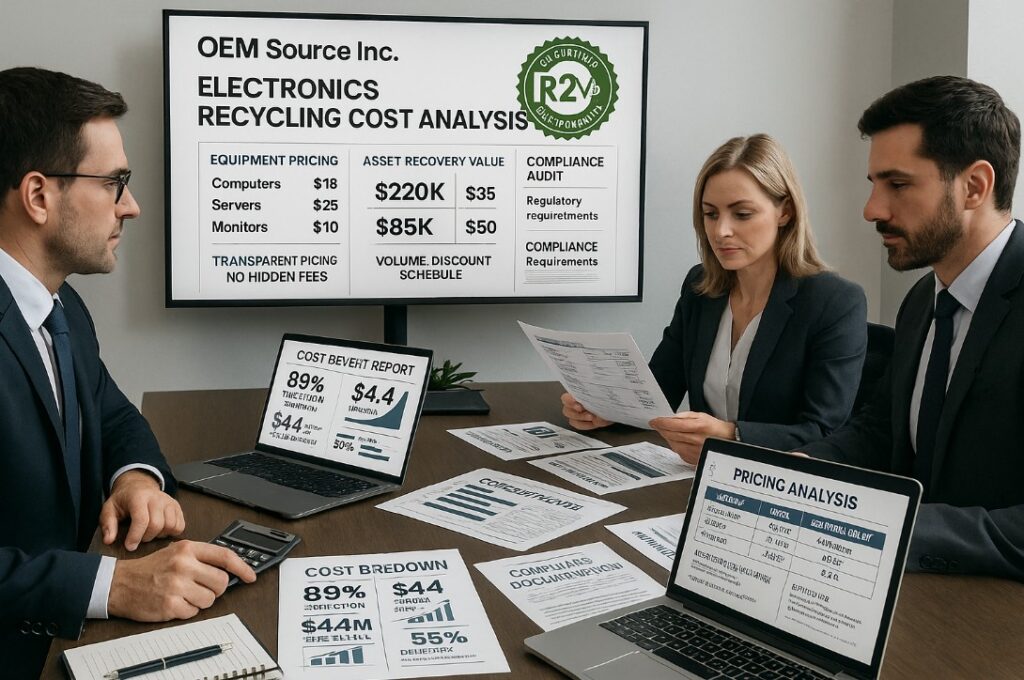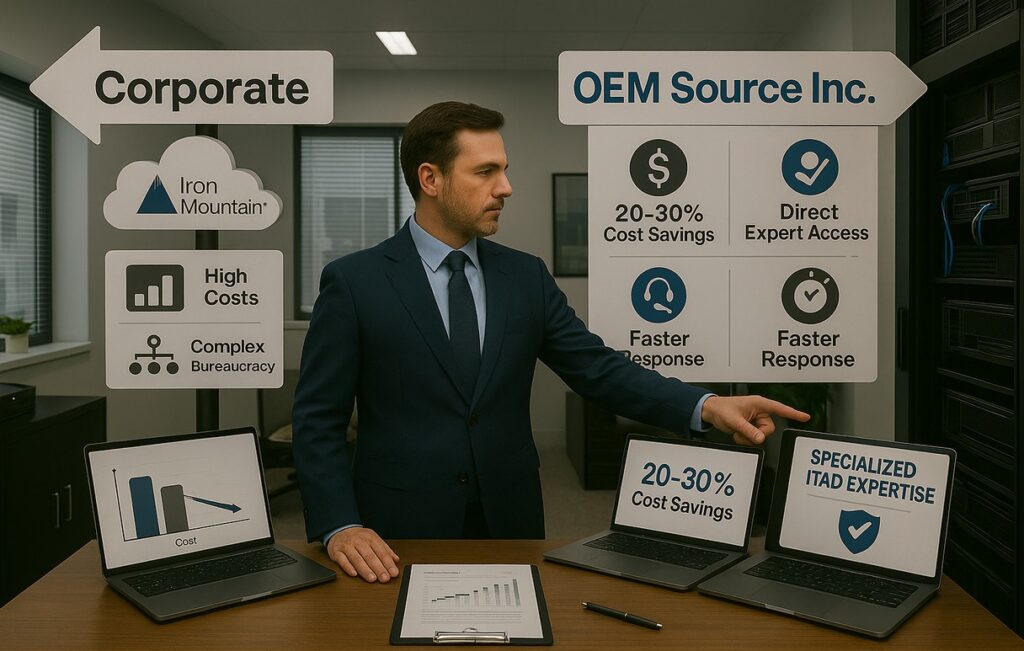Old telecom equipment—phones, servers, network devices, and other hardware—piles up fast in our digital world and needs proper disposal when they reach end-of-life. Telecom equipment recycling offers a sustainable solution that protects the environment while helping companies recover value from outdated assets.
When recycling telecom equipment, working with specialized e-waste recyclers ensures proper handling of potentially hazardous materials. These professionals first try to reuse working components before breaking down items for raw material recovery. This approach maximizes both environmental and financial benefits for your organization.
Reputable recycling partners also use certified data destruction processes to protect your sensitive information. Many of which offer detailed documentation to verify proper disposal, helping you meet compliance requirements for your industry.
The Importance of Telecom Equipment Recycling
Telecom equipment recycling offers significant advantages for businesses and the environment. Proper disposal practices help conserve natural resources while meeting legal requirements that govern electronic waste management.
Environmental Benefits
Recycling telecom equipment significantly reduces the amount of e-waste in landfills, protecting soil and water from contamination.
Network equipment contains recoverable materials like copper, aluminum, gold, and rare earth metals that can be extracted and reused. By diverting equipment from landfills, you help:
- Conserve valuable natural resources.
- Decrease pollution and reduce greenhouse gas emissions associated with manufacturing
- Promote circular economy principles through reuse and material recovery
Many responsible recycling companies now implement a zero-landfill policy, ensuring that all components are either reused or processed for material recovery. This approach minimizes waste and maximizes the value recovered from obsolete equipment.
Regulatory Compliance
Your business must comply with various regulations governing e-waste disposal. Many regions have specific laws that prohibit disposing of electronic equipment in regular waste streams.
Non-compliance with e-waste regulations can result in significant penalties including fines and legal action. By establishing proper recycling protocols, you protect your organization from these risks.
Data security regulations also play a crucial role in equipment disposal. Proper recycling ensures secure data destruction, helping you meet privacy requirements like GDPR, HIPAA, or other industry-specific regulations.
Many telecom equipment manufacturers now offer take-back programs to help customers comply with regulations. These programs often align with extended producer responsibility principles, making compliance easier for your organization.
Working with certified e-waste recyclers ensures your disposal methods meet all regulatory standards and that documentation is properly maintained for audit purposes.
Types of Telecom Equipment
Telecommunications networks rely on various equipment to function efficiently. Understanding these different types of hardware can inform smarter decisions about recycling and reusing obsolete equipment.
Modems and Routers
Modems convert digital signals from your devices into analog signals that can travel through telephone or cable lines—serving as the gateway between your local network and the internet. Most modern homes use combination modem-router units for simplicity.
Routers, on the other hand, direct data packets between networks. They essentially manage traffic between your devices and the internet.
They come in various forms including:
- Residential routers: Typically used in homes and small offices
- Enterprise routers: More powerful units for business networks
- Wireless routers: Include Wi-Fi capabilities
- Mesh routers: Systems that provide wider coverage through multiple units
These devices contain valuable materials like copper, aluminum, and circuit boards that can be recycled and recovered. When upgrading your network equipment, consider proper recycling options rather than disposal.
Switches and Hubs
Switches connect multiple devices within a network and intelligently direct data only to its intended destination. They operate at layer 2 (data link layer) of the network model and make decisions based on MAC addresses.
Types of switches include:
- Managed switches: Configurable for complex networks
- Unmanaged switches: Plug-and-play for basic networking
- PoE switches: Provide power over ethernet
Hubs are simpler devices that broadcast all data to every connected port. While less efficient than switches, older networks may still use them.
Like modems and routers, these networking components contain recyclable materials such as metals and plastics. Many businesses replace these components during network upgrades, creating opportunities for recycling or refurbishment.
Servers and UPS Systems
Servers are powerful computers that store, process, and manage network resources. They handle everything from email and file storage to hosting websites and applications. Telecom recycling facilities can process various server types:
- Rack servers: Mounted in standardized racks for data centers
- Tower servers: Standalone units similar to desktop computers
- Blade servers: Thin, modular servers housed in chassis systems
UPS (Uninterruptible Power Supply) systems provide backup power to keep equipment running during outages. They contain batteries that require special handling during recycling due to their chemical components.
When recycling servers and UPS systems, data security is crucial. Ensure all data is properly wiped and documented before disposal.
Many recycling programs offer certificates of destruction for sensitive equipment. You should also consider asset recovery programs that may provide value for newer equipment that can be refurbished.
Data Security and Destruction Processes
Effective disposal begins with identifying outdated equipment and applying appropriate sanitization methods.
Protecting sensitive information when recycling telecom equipment requires strict protocols. Proper data destruction prevents unauthorized access and complies with privacy regulations that safeguard both your company and customers.
Secure Data Destruction
When disposing of telecom equipment, you need reliable methods to permanently remove data.
Physical destruction services like hard drive shredding offer the highest security level by making data recovery physically impossible. This approach works well for storage devices that cannot be reused.
For reusable equipment, certified data wiping software provides a secure alternative. These programs overwrite existing data multiple times, ensuring it cannot be recovered. Many recycling partners offer on-site destruction options, allowing you to witness the process firsthand.
Common destruction methods include:
- Hard drive shredding
- Degaussing (magnetic erasure)
- Crushing or punching
- Certified data wiping
Always request a Certificate of Destruction for your records and compliance documentation. These certificates verify the destruction process and serve as proof during audits or regulatory reviews
Data Sanitization Standards
To ensure full compliance, your telecom equipment recycling must follow established data sanitization standards. The National Institute of Standards and Technology (NIST) guidelines specify proper data removal techniques for different media types and security levels.
Key standards include:
- DoD 5220.22-M: The Department of Defense standard requires multiple overwrites of all storage sectors
- NIST 800-88: Defines three sanitization levels:
- Clear – Basic overwriting of data
- Purge – Advanced techniques that prevent laboratory recovery
- Destroy – Complete physical destruction of media
Most telecom companies must comply with industry-specific regulations like HIPAA, GDPR, or PCI DSS depending on the data types.
Before recycling, verify your recycling partner offers data destruction services that meet these standards to maintain compliance and security.
IT Asset Recovery and Remarketing
IT asset recovery involves reclaiming value from retired technology while ensuring proper data security. The process combines strategic remarketing with careful tracking to maximize returns on your outdated equipment.
Maximizing Resale Value
To get the most from your retired telecom equipment, proper evaluation is essential. Asset remarketing programs can help you assess the current market value of your devices before making decisions.
You should consider these value-boosting strategies:
- Professional refurbishment: Cleaning, repairing, and updating equipment can increase value by 15-30%
- Component harvesting: When full units aren’t marketable, valuable parts can be sold separately
- Timing considerations: Releasing equipment when demand is high yields better returns
Data sanitization is essential before remarketing. Secure data destruction protects your company from potential breaches and compliance issues.
Work with specialists who understand both the technical and market aspects of your equipment. They can identify items with surprising resale potential that might otherwise be recycled.
Asset Tracking and Logistics
Implementing robust tracking systems ensures accountability throughout the recovery process. Your equipment’s journey should be transparent from decommissioning to final disposition.
Key tracking elements include:
- Inventory documentation with model numbers, conditions, and specifications
- Chain-of-custody records that prevent loss during transport
- Compliance verification ensuring proper handling of regulated materials
Professional asset recovery providers offer specialized logistics services including safe de-installation and transportation. These services protect equipment value during transit and reduce your internal resource burden.
Your reporting should include environmental impact metrics as well. Track how many pounds of material were diverted from landfills and how much carbon was saved through reuse versus new manufacturing.
For additional visibility, consider implementing a secure client portal where you can monitor your assets in real-time. This transparency builds confidence in the process and helps with regulatory documentation needs.
Certifications and Partnerships
Proper certifications and strategic partnerships ensure your telecom equipment recycling process meets environmental standards while also providing confidence in data security. These credentials demonstrate commitment to responsible practices and sustainable operations.
LEED Certification and Green Partnerships
LEED certification plays a key role in telecom recycling by recognizing environmentally responsible practices. When you partner with LEED-certified recycling facilities, you contribute to your organization’s sustainability goals.
Proper equipment disposal can help your company earn LEED points, supporting green building certifications and showcasing your environmental commitment to stakeholders.
Green partnerships extend beyond basic recycling. By aligning with organizations focused on sustainability, you gain access to specialized knowledge and resources. These partnerships often include:
- Waste reduction programs
- Carbon footprint assessments
- Circular economy initiatives
Look for recycling partners who maintain relationships with environmental non-profits and sustainability-focused business networks. These connections demonstrate their commitment to broader environmental goals beyond basic compliance.
Industry Certifications for Recycling
Essential industry certifications provide assurance that your telecom equipment is handled responsibly. Look for recyclers that hold the following:
- R2 certification: Covers not just the primary recycling facility, but extends to all downstream vendors, giving you confidence in the entire recycling chain.
- ISO certifications: Issued by the International Organization for Standardization (ISO), such as:
- ISO 9001
- ISO 14001
- ISO 45001
- T11 Exemption: Allows facilities to dismantle, repair, and refurbish equipment under certain regulations.
- Data destruction certifications: Ensure sensitive information is properly eliminated. For example, NAID AAA Certification.
Your recycling partner’s certifications should match your specific needs, especially regarding data security and environmental compliance. Regularly review their certification status to ensure continued compliance with evolving standards.
Strategies for Effective Telecom Equipment Recycling
Recycling telecom equipment properly requires clear strategies that protect the environment and your company’s data. These approaches help maximize value recovery while meeting regulatory requirements.
Implementing a Zero-Landfill Policy
A zero-landfill policy commits your organization to ensure no telecom equipment ends up in landfills. This approach is becoming essential for environmentally responsible companies.
To implement a successful policy:
- Auditing all equipment disposal practices. Look for gaps where items might be improperly discarded.
- Partner with certified e-waste recyclers who guarantee complete processing of materials. These specialists break down equipment into components that can be reused or properly recycled.
- Document your disposal process thoroughly to demonstrate compliance with environmental regulations. This documentation also helps track your sustainability progress.
- Set measurable goals for waste reduction and communicate them throughout your organization.
- Train staff on proper disposal procedures ensures everyone follows the policy.
Benefits of zero-landfill approach include:
- Reduced environmental impact
- Enhanced brand reputation
- Potential eligibility for tax incentives
- Alignment with corporate ESG goals
Lifecycle Management of Telecom Assets
Effective asset lifecycle management begins before equipment is even purchased.
Best practices include:
- Consider end-of-life disposal when making purchasing decisions.
- Implement a detailed inventory system that tracks all telecom assets from purchase to disposal. Include information like purchase date, expected lifespan, and maintenance history.
- Extend equipment life with regular maintenance and schedule routine checks and updates to prevent premature replacement.
- Evaluate it for potential reuse or refurbishment when equipment reaches end-of-life. Many components retain value even when the full system is outdated.
- Prioritize secure data destruction for items that can’t be reused. Work with specialists who can certify complete data removal before recycling proceeds.
- Create a formalized retirement process that includes approval steps, data security verification, and proper documentation of disposal methods.
Future Trends in Telecom Recycling
The telecom industry is embracing circular practices that will transform equipment recycling in the coming years. These innovations promise both economic benefits and positive environmental impacts for operators and consumers alike.
Innovations in Recycling Technology
Advanced Material Recovery techniques are evolving rapidly. By 2025, telecoms will develop more sophisticated methods to extract valuable metals from outdated equipment. New automated systems can now separate components with 95% accuracy, a significant improvement over manual processes.
AI-Powered Sorting is revolutionizing recycling efficiency. These systems can identify and categorize components faster than ever before, reducing processing time by up to 60%.
“Urban Mining” has led operators to discover that they’re sitting on billions of dollars worth of copper in old infrastructure. This opportunity will lead to specialized extraction services becoming mainstream by late 2025.
Modular Design approaches are making newer equipment easier to disassemble and recycle. You’ll see more products with components that can be removed and replaced without specialized tools.
Global Impact of Sustainable Practices
Major telecom companies like Orange and BT have established specific targets for circular economy initiatives. These goals focus on reusing, refurbishing, and recycling network equipment rather than disposal.
The financial incentives are compelling. You can expect cost savings of 15-25% when choosing refurbished equipment over new purchases. This drives both corporate and consumer behavior toward more sustainable choices.
Carbon Footprint Reduction is becoming measurable and reportable. When you recycle telecom equipment, you help companies meet their sustainability goals while reducing greenhouse gas emissions.
Regulatory Pressure is increasing globally. By 2025, more countries will implement extended producer responsibility laws that require telecom companies to manage equipment throughout its lifecycle. You’ll see more take-back programs and recycling incentives as a result.
Frequently Asked Questions
Businesses and individuals often have questions about telecom equipment recycling. These answers provide guidance on processes, accepted items, regional considerations, provider selection, data security, and environmental impacts.
What is the process of recycling telecommunication equipment?
The telecom recycling process typically begins with collection and sorting of equipment. Your items will then undergo data wiping to remove sensitive information.
Next, technicians will disassemble the equipment and separate valuable materials like copper, gold, and other metals. These materials are then processed for reuse in manufacturing.
Some components may be refurbished for resale if they remain functional. Non-recyclable parts are disposed of according to environmental regulations.
Which types of telecommunication equipment are accepted for recycling?
The telecom recycling process typically begins with collection and sorting of equipment. Your items will then undergo data wiping to remove sensitive information.
Next, technicians will disassemble the equipment and separate valuable materials like copper, gold, and other metals. These materials are then processed for reuse in manufacturing.
Some components may be refurbished for resale if they remain functional. Non-recyclable parts are disposed of according to environmental regulations.
Additionally, many facilities take new, used, or surplus telecom phones and systems. You can typically recycle photocopiers, printers, shredders, and toner cartridges as well. Check with your recycler for a complete list of accepted items.
Servers, modems, and cable equipment
- Desk phones and mobile phones
- PBX systems, modems, and routers
- Switches and network hardware
Most recycling facilities accept a wide range of telecom equipment, including
Are there specific recycling solutions for telecommunication equipment in California?
Yes. California has strict e-waste regulations under the Electronic Waste Recycling Act. You must work with certified e-waste recyclers who comply with state standards.
The state offers collection events throughout the year where you can drop off telecom equipment. Many recyclers provide certificates of destruction that comply with California’s documentation requirements.
California businesses must follow specific disposal regulations for equipment containing batteries or hazardous materials. Local recycling solutions often include free pickup services for large quantities.
What should be considered when selecting a telecom equipment recycling provider?
Yes. California has strict e-waste regulations under the Electronic Waste Recycling Act. You must work with certified e-waste recyclers who comply with state standards.
The state offers collection events throughout the year where you can drop off telecom equipment. Many recyclers provide certificates of destruction that comply with California’s documentation requirements.
California businesses must follow specific disposal regulations for equipment containing batteries or hazardous materials. Local recycling solutions often include free pickup services for large quantities.
How can businesses ensure data security when recycling their telecom equipment?
Yes. California has strict e-waste regulations under the Electronic Waste Recycling Act. You must work with certified e-waste recyclers who comply with state standards.
The state offers collection events throughout the year where you can drop off telecom equipment. Many recyclers provide certificates of destruction that comply with California’s documentation requirements.
California businesses must follow specific disposal regulations for equipment containing batteries or hazardous materials. Local recycling solutions often include free pickup services for large quantities.
What are the environmental benefits of recycling outdated telecommunications technology?
Telecom recycling offers several environmental advantages:
- Reduces the need for raw material extraction. This conserves natural resources and decreases the environmental impact of mining.
- Prevents hazardous materials like lead, mercury, and cadmium from contaminating landfills and water supplies. These toxins can cause significant environmental damage if improperly disposed of.
- Reduces energy consumption compared to manufacturing new equipment.
For example, a single recycled smartphone can save enough energy to power a laptop for 44 hours.





